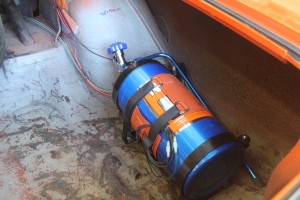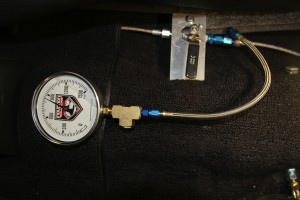I recently installed a NOS Cheater nitrous system on my car and we took it to a chassis dyno to test the system. The jets were rated at 150 hp but when we tested it, it only delivered barely 100 hp. The guy who runs the dyno said my fuel pressure was okay but the bottle pressure was low. He said I had to heat the bottle. Doesn’t that make the nitrous hot and not a liquid? I don’t understand how this works.
J.T.
Jeff Smith: I can see how you might be confused, but your dyno operator is correct. Let’s start with some basics. Nitrous is normally a gas, but when pressurized, this gas turns into a liquid. When a nitrous bottle is filled, it adds a given volume of liquid nitrous oxide (N2O). The company that fills your bottle simply measures the amount of liquid nitrous with a scale. If you look on the label of a typical 10-pound nitrous bottle, it will list the weight of the bottle, the weight of the correct amount of nitrous, and then a total the bottle should weigh when properly filled. For example, the 10-pound NOS bottle in my shop reads 14 pounds 12 ounces for the bottle plus 10 pounds for the weight of the gas equals 24 pounds 12 ounces as the weight when the bottle is properly filled. When the nitrous shop fills your bottle, generally it will be cold. This makes it easier to fill the bottle. When the bottle is cold, the pressure is relatively low.
All nitrous companies configure their systems to make power with a tune consisting of several variables. The most obvious ones are the nitrous and fuel jets fitted to the plate. These are what most enthusiasts want to experiment with. We’ll leave them for a moment because there are two other variables that you must control before we even get to the jets. The first is bottle pressure. Once the filled bottle’s temperature has stabilized, the nitrous will exert a given pressure based on the temperature of the contents of the bottle. You can measure this two ways–with pressure or with temperature. A simple way that is relatively accurate is to measure the bottle temperature with an infrared temperature gun. We’ve included a temperature vs. pressure chart that will indicate pressure based on the bottle temperature (below). But you should know that this is not quite as accurate as knowing the actual pressure. This is because you are measuring the temperature of the bottle surface, which may be slightly warmer than the contents inside the bottle. The difference is slight, but it is a variable worth considering.
As the temperature of the contents of the bottle rises, the pressure increases. This is basic physics, but the important thing to remember is that the amount of nitrous delivered by any nitrous system is directly dependent upon pressure. The more pressure, the more nitrous is delivered. Since the jets are a given size, the system is tuned for a given pressure to feed a known amount of liquid nitrous at that pressure.
Note that I said liquid nitrous. Nitrous oxide is a gas, but once it is pressurized above 735 to 750 psi, this pressure changes the gaseous nitrous to a liquid. This conversion doesn’t happen all at once, but gradually over a range rather than just at 735 psi. This is why bottle pressure is important. As you can see by our accompanying chart (below left), at 70 degrees F, the bottle pressure is 760 psi–barely above the point where nitrous changes state.
Nitrous Temperature vs. Pressure
| Bottle Temp. (Degrees F) | Bottle Pressure (psi) |
|---|---|
| 0 | 283 |
| 10 | 335 |
| 20 | 387 |
| 32 | 460 |
| 40 | 520 |
| 50 | 590 |
| 60 | 675 |
| 70 | 760 |
| 80 | 865 |
| 85 | 950 |
| 97 | 1,069 |
On a hot summer day with the bottle in the trunk of your car, the bottle could easily be warmer than 85 degrees. Conversely, on a cool spring evening, the nitrous in the bottle could easily be 65 degrees F. As you can see, it’s critical to maintain bottle temperature in order to maintain the pressure as close to 950 psi as possible. While using a temp gun will get you close, the best way to know the pressure is to measure it. I use a large, liquid-filled nitrous pressure gauge to monitor system pressure. I routed my nitrous line through the interior along with a valve that allows me to open nitrous pressure to the solenoid only right before I make a pass down the drag strip. Induction Solutions owner Steve Johnson says that minimizing the time the solenoid seal is exposed to pressure will greatly extend the nitrous solenoid’s seal life expectancy. He recommends only applying pressure to the solenoid right before making a run and then turning the valve off and bleeding the pressure with a purge valve directly after a run. Johnson says that if you do this, the seals in the nitrous solenoid will last a very long time. Plus, this also guards against a solenoid leak that could cause a backfire in the manifold.Nitrous kits are designed to flow liquid nitrous, which is far more dense and therefore more potentially powerful. Therefore, it’s important that bottle pressure be at the sweet spot of 950 psi, which is where nearly all nitrous companies choose as their tuning pressure. Looking at the chart again, it’s obvious that the contents of the bottle need to be as near 85 degrees F as possible in order to be at 950 psi.

The best way to maintain pressure is with an electric bottle heater like this one from NOS. These heaters are designed with a thermostat to maintain a bottle temperature of 85 degrees F.
The best way to maintain bottle pressure is with a nitrous heater. Most nitrous companies like NOS, ZEX, and others sell an electric heater that is hooked to the car’s electrical system. Most kits also have a temperature sensor that will turn the heater on and off based on the bottle temperature. It’s best to only leave the heater on when you can monitor the pressure to ensure the pressure does not become excessive. You may have heard or seen guys trying to increase bottle temperature by applying an open flame to the bottle Never attempt this. Open flame on a bottle can cause a stress fracture that can instantly turn that bottle into a 900 psi bomb. There are several examples of people being killed by an exploding bottle. If you see someone heating a bottle with an open flame, leave the area immediately so they don’t injure you with their stupidity. If you have to warm a bottle quickly, stick it in a container with warm water–it only takes a few minutes to increase the bottle up to working pressure and this is completely safe as long as you carefully monitor the bottle pressure.

This is the 4-inch diameter Induction Solutions nitrous pressure gauge. I’ve mounted mine in the interior next to a high flow quarter-turn valve. The gauge is mounted on the bottle side so I can read pressure even with the valve turned off. If the bottle pressure is too high, I can reduce it to 950 psi with a purge solenoid. In this photo, the pressure gauge reads 840 psi which is too low and will need to be raised to 950 psi for best results.
The second most important tuning variable is fuel pressure. Most kits will specify the fuel pressure they use to tune the system. Generally, this will be 5 to 5.5 psi, but check with your kit manufacturer for the proper pressure. It’s also important to monitor the dynamic fuel pressure to make sure the pressure is actually where you set it. The best way to know the dynamic fuel pressure is to test it. You can do this with an accurate pressure gauge. ZEX sells a tool to perform this test, but you can make your own if you like. Let’s say you have a separate fuel pump for the nitrous system. The tool uses a T to sense fuel pressure while flowing the amount of fuel with a jet that dumps fuel into a separate fuel can. Disconnect the fuel inlet line to the fuel solenoid, connect the T with the pressure gauge and the other end of the fuel line will have a jet on the end that is the same size as your fuel jet. Turn the fuel pump on and dump fuel exiting the jet into a fuel can. The dynamic fuel pressure can be read on the gauge. If it’s not the correct pressure, you will need to adjust it with a fuel pressure regulator until the pressure is correct. This will establish the correct dynamic fuel pressure when the nitrous system is engaged.
There’s much more to nitrous tuning but these two major tuning issues represent the critical points to ensure your nitrous system makes horsepower safely.

[…] Read More […]
When I play golf my nitrous bottle sits in my trunk
And is well over 100 degrees in Deep South Texas.
My gauge goes way into the red. Is this safe?
All nitrous bottles are certified to be able to withstand 1,800 psi. At 100 degrees F your bottle is seeing roughly 1,000 psi pressure, which is why your gauge is in the red. There is a safety relief valve located on the bottle valve that will release pressure if it exceeds a given pressure of roughly 85 percent of the rated pressure. But not all these valves will release at the same pressure. However, we’ve seen overheated bottle explode instead when the relief valve did not do its job. This is like a small bomb exploding inside your car – not good. The smart thing is just to remove the bottle when you’re not using it and store it in a cool place where it will not see excessive heat. Also always leave the nitrous bottle pressure valve closed until right before you intend to use it. This keeps the load off the nitrous solenoid seal.
is overheated? I ran an external “blanket” and got bottle up to 1150 psi and hit it. `12.5:comperession 350.0 Chevy. 34 meancial. 99 weighted otance. how does the voulem you uae effect “bottle pressure”. Its seem like highwe pressure 1200psi havfea ton of torque but fall down above 5000rpm? Was the nitrous too warm 4o5 seconds into run? Thanks.
Did anyone know if the nitrous solenoid seals will go bad if a motor sits for a period of a few years? Or will they be ok if there not under pressure?
One other question. Does anyone think that you need to top off the nitrous bottles to full after every single run. Many do this but I cannot see the reasoning why? As long as you have 900 to 950 psi what’s the difference?
My nitrous pressure gauge is on my hood just before the solenoid It T;s one goes to solenoid the other to the gauge , and to open valve is on the tank bottle in the trunk SOOOOO…… can I open valve on bottle to see my pressure as the tank heater is on !! ??
I’m not sure about this but can u use nos on a diesel motor I have a original 89 5.9 Cummins I’m using for drag racing and I didn’t know if u could use it with diesel or not